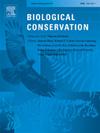Habitat disturbance alters movement behaviour in a social Afrotropical forest bird
IF 4.9
1区 环境科学与生态学
Q1 BIODIVERSITY CONSERVATION
引用次数: 0
Abstract
Animal movement is crucial for fitness and is influenced by resource availability and social dynamics. Habitat degradation changes resource availability, impacting movement behaviour and habitat use. However, responses vary among species, and the role of sociality is unclear. Thus, a better understanding of how and why habitat degradation affects animal movement patterns is important for effective conservation. We studied the impact of forest degradation on the movement behaviour of the placid greenbul Phyllastrephus placidus, a cooperatively breeding bird, in the cloud forest fragments of the Taita Hills in Kenya, which are part of the Eastern Arc Mountains biodiversity hotspot. Individuals covered greater distances and occupied larger home ranges in heavily degraded than in less degraded forest. This was probably due to decreased canopy cover in degraded forest as travel distance and home-range size were inversely related to canopy cover within the home range. In addition, in the degraded forest, individuals were found preferentially in sites with higher mean canopy height than the mean canopy height calculated over the entire home range. Group sizes were not related to home-range size or travel distances. Thus, forest degradation seems to reduce the availability of suitable foraging patches and increase resource dispersion, but not resource richness within foraging patches. The study highlights the need to develop strategies to prevent further degradation of canopy cover in the Taita Hills and other tropical forest ecosystems to ensure the long-term persistence of tropical forest species.
求助全文
约1分钟内获得全文
求助全文
来源期刊

Biological Conservation
环境科学-环境科学
CiteScore
10.20
自引率
3.40%
发文量
295
审稿时长
61 days
期刊介绍:
Biological Conservation is an international leading journal in the discipline of conservation biology. The journal publishes articles spanning a diverse range of fields that contribute to the biological, sociological, and economic dimensions of conservation and natural resource management. The primary aim of Biological Conservation is the publication of high-quality papers that advance the science and practice of conservation, or which demonstrate the application of conservation principles for natural resource management and policy. Therefore it will be of interest to a broad international readership.
 求助内容:
求助内容: 应助结果提醒方式:
应助结果提醒方式:


